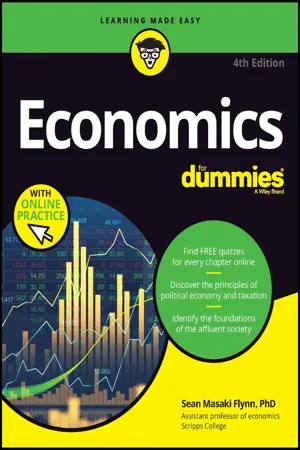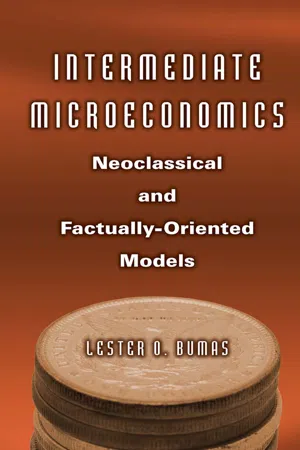Economics
Marginal Revenue
Marginal revenue refers to the additional revenue generated from selling one more unit of a product. It is calculated by dividing the change in total revenue by the change in quantity sold. Understanding marginal revenue is crucial for businesses to make pricing and production decisions, as it helps determine the optimal level of output to maximize profits.
Written by Perlego with AI-assistance
Related key terms
Related key terms
1 of 4
Related key terms
1 of 3
7 Key excerpts on "Marginal Revenue"
- eBook - ePub
Natural Resources and the Environment
Economics, Law, Politics, and Institutions
- Mark Kanazawa(Author)
- 2021(Publication Date)
- Routledge(Publisher)
it is no longer true that price equals MR .The reason has to do with the fact that the monopolist has the market all to himself. Being in the enviable position of servicing the entire market, he experiences something that the small competitive firms did not: as he sells more, the price he is able to charge goes down . This occurs as he moves along the downward-sloping demand curve, as in Figure 2.13 . Suppose he is originally selling the quantity Q0 at the price P0 . If he sells one more unit, the price will fall to P1 . Notice what happens to total revenue: it was originally (P0 X Q0 ), but it is now (Q0 + 1), the new quantity sold, times the new lower price P1 . It is not (Q0 + 1) times the original P0 , which it would have been if the price had remained where it was, at P0 .Figure 2.13Marginal Revenue for a monopolySo what is the MR, the additional revenue to the monopolist of selling the extra unit? Yes, he is gaining extra revenue on the sale of the extra unit, represented in Figure 2.13 as the shaded area A, which happens to be equal to the price P1 . However, this extra revenue is offset by the lost revenue from having to sell all the units he had previously sold at the price P0 at the new lower price P1 . This lost revenue is the shaded area B. This means that his Marginal Revenue MR is equal to (A – B). So: we have just established that the Marginal Revenue in moving from Q0 to (Q0 - eBook - ePub
- John H Hoag(Author)
- 2012(Publication Date)
- WSPC(Publisher)
To make progress toward understanding how this assumption yields results, we need to move forward with our discussion of the general revenue concepts. We will then develop the revenue concepts for competitive firms, which we will then combine with the cost concepts of the previous chapter to obtain profit. Once we have profit, we can move to profit maximization, the shutdown condition, and the firm’s supply curve. Here we go!5.2 Revenue ConceptsIn this section, we will develop the revenue concepts that will be used for all firms. When we are done with the general concepts, we will turn to the particular case of the competitive firm and see what the revenue curves look like in this case. We begin with definitions.Definition 5.1: Total revenue (TR) is a relationship between output and dollars showing price, P, times quantity sold, X.We can use a formula to find total revenue: TR(X) = P × X.Definition 5.2: Marginal Revenue (MR) is a relationship between output and dollars per unit of output showing the change in total revenue due to a change in output at each level of output.We can think of MR in a variety of ways. We can find the MR by using the following formula: . Alternatively, MR is the slope or derivative of TR. You should realize that we can use the fundamental theorem here.Exercise 1. State the fundamental theorem using MR and TR.Definition 5.3: Average revenue (AR) is a relationship between output and dollars per unit of output showing total revenue per unit of output.Again, we can use a formula to compute the average revenue: . But there is one more concept we need, and we define it now, even though it is not a revenue concept.Definition 5.4: Profit (π) is a relationship between output and dollars showing the total revenue minus the total cost at each output.You can see that profit is a total relationship, as it involves output and dollars, not an average or marginal relationship that involves output and dollars per unit of output. You should also see that the profit could be negative; there is nothing in the definition that guarantees profit is positive. We use the word “profit” for both the case where the profit is positive and the profit is negative. You will also note that we have not defined marginal or average profit. We leave that to you now. - eBook - ePub
- Rob Dransfield(Author)
- 2013(Publication Date)
- Routledge(Publisher)
For example, a producer knows that the 1,000th unit of production will cost 50 pence to produce but will yield 60 pence worth of revenue. So it makes sense to make that unit. The producer knows that the 1,100th unit will cost 59 pence to produce but will yield 60 pence worth of revenue. So it makes sense to make that unit. However, the 1,101st unit will cost 60 pence to produce and will yield 60 pence worth of revenue. So that is the last unit that will be produced. You can see why. The 1,102nd unit may cost 61 pence to produce – so the producer would be making a loss of 1 penny from producing that unit. 4.7 A marginal approach to profit maximizing At the start of this chapter we showed how a business can carry out cost–volume–profit analysis to identify how much profit can be made at different levels of output. What we want to show you now is an approach used by economists to identify the profit maximizing point for a firm. The approach is based on marginal analysis. This analysis involves:- Explaining how Marginal Revenue can be derived from a demand curve.
- Explaining the relationship between marginal costs and average costs.
- Illustrating how the point at which marginal cost equals Marginal Revenue is the profit maximizing point.
In Chapter 3 we saw that a typical demand curve is downward sloping. To sell more goods we have to lower prices.Another way of thinking about the demand curve is that it illustrates ‘average revenue’. For example, in Figure 4.10 when the business charges a price of £8 the demand for its product is 600 units. The average revenue for each of these units is therefore £8.If the business charges a price of £6 the demand for its product is 1,000. The demand curve and average revenue are thus the same. Deriving Marginal Revenue from the demand curveFigure 4.10 Average revenue = priceIn order to increase sales a business needs to lower the price of the units that it sells. As a result the Marginal Revenue generated will always be less than the price the firm is able to charge for the unit sold (because the firm has had to lower the price of all of the units that it sells in order to make additional sales). - eBook - ePub
- (Author)
- 2023(Publication Date)
- Wiley(Publisher)
most likely result would be:- a 10% increase in total revenue.
- a 10% increase in average revenue.
- a less than 10% increase in total revenue.
Solution:A is correct. In a perfectly competitive market, an increase in supply by a single firm will not affect price. Therefore, an increase in units sold by the firm will be matched proportionately by an increase in revenue.The Marginal Revenue per unit sold for a firm doing business under conditions of perfect competition will most likely be:- equal to average revenue.
- less than average revenue.
- greater than average revenue.
Solution:A is correct. Under perfect competition, a firm is a price taker at any quantity supplied to the market, and AR = MR = Price.A profit maximum is least likely to occur when:- average total cost is minimized.
- Marginal Revenue is equal to marginal cost.
- the difference between total revenue and total cost is maximized.
Solution:A is correct. The quantity at which average total cost is minimized does not necessarily correspond to a profit maximum.The short-term breakeven point of production for a firm operating under perfect competition will most likely occur when:- price is equal to average total cost.
- Marginal Revenue is equal to marginal cost.
- Marginal Revenue is equal to average variable costs.
Solution:A is correct. Under perfect competition, price is equal to Marginal Revenue. A firm breaks even when Marginal Revenue equals average total cost. - eBook - ePub
Economics For Dummies
Book + Chapter Quizzes Online
- Sean Masaki Flynn(Author)
- 2023(Publication Date)
- For Dummies(Publisher)
change in total revenue, the entries in the Marginal Revenue column are displayed between the two total revenue figures to which they correspond. For instance, total revenue increases from $0 to $9 as you move from producing no output to one unit of output. That’s why I place the Marginal Revenue of $9 between the total revenue entries of $0 and $9.As you see in Figure 8-1 , the Marginal Revenue (MR ) curve starts at the same point as the demand curve, but it falls with twice the slope. It hits the horizontal axis at an output level of instead of the output level at which demand hits the horizontal axis (where q stands for quantity produced).Relating Marginal Revenue to total revenue
You can get a handle on why the monopolist’s Marginal Revenue curve falls so quickly if you first examine total revenue, or TR. The total revenue that the monopolist can get is simply the output it produces times the price at which it can sell its output. That is, . However, the price at which a monopolist can sell depends on how much the firm produces.The relationship between the output produced and the price at which the product can be sold depends on the demand curve. For instance, consider Point A on the demand curve in Figure 8-1 . At that point, one unit is being produced, and it can be sold for $9. Consequently, the total revenue at that point is $9. Next, look at Point B, at which two units of output are being sold. At that output level, each unit can be sold for $8. Consequently, total revenue is . And at Point C, where three units can be sold for $7 each, total revenue is $21.The important thing to notice is how total revenue changes as you move from A to B to C and output increases from one to two to three units. Total revenue goes from $9 to $16 to $21. Obviously, total revenue increases. But look more deeply. Moving from A to B, TR increases by $7 (from $9 to $16). But moving from B to C, - eBook - ePub
Intermediate Microeconomics
Neoclassical and Factually-oriented Models
- Lester O. Bumas(Author)
- 2015(Publication Date)
- Routledge(Publisher)
As long as the market demand in a competitive market is inelastic at the market price, Marginal Revenue is negative. In the above example assume that oranges are sold to consumers for $10 a bushel with the grower receiving $4 a bushel. With an elasticity of demand of −0.62, the sale of the marginal bushel yielded a Marginal Revenue of −$6.13 (MR = P (1 + 1/E) = 10 (1 + 1/−0.62) = −$6.13). With the citrus grower receiving 40 percent of this, the Marginal Revenue received from growing the last bushel of oranges is −$2.45. (The derivation of the formula relating Marginal Revenue to price and the price elasticity of demand can be found in Appendix A.1.)The graphical approach requires the proper location of the elasticity of −0.62 on the market demand function, as in Figure 7.12 . The location is such that at this elasticity the ratio of the two segments of the demand function is 0.62 to 1. The second matter is that for a linear demand function, the Marginal Revenue function comes down at double the negative slope. Then a careful drawing shows that at the quantity sold at $10 a bushel, Marginal Revenue is −$6.13 per bushel. Citrus fruit growers would maximize their total revenue and profits if the crop destruction continued until the supply equaled demand at unitary price elasticity of demand.It would be irrational for a firm to produce to the extent that its Marginal Revenue is negative. Does this become rational when the source of the negative Marginal Revenue is the market?Efficiency and the Competitive Market
Efficiency, in a general sense, is the ratio of output to input. Most power generating plants transform fuel—coal, oil, and gas—into electrical energy. Their efficiency is the ratio of the energy they produce to the energy content of the fuels used. The efficiency of a light bulb is the ratio of the illumination to the energy used to obtain that illumination. Maximum efficiency occurs when either maximum output is obtained from a given input or a given output is obtained from the minimum input. - eBook - ePub
Health Economics For Nurses
Intro Guide
- Stephen Morris(Author)
- 2014(Publication Date)
- Routledge(Publisher)
We may wish to know the rate at which costs rise as output increases. To do so we use the notion of marginal cost, which is analogous to the concept of marginal utility to the consumer. Marginal costMarginal cost (MC) is the cost of producing one unit more or less of a good. It is the increase in total costs from producing an extra unit of output. So, if nine chocolate bars cost 50p to produce, and ten chocolate bars cost 60p to produce, then the marginal cost of producing the tenth chocolate bar is 10p. Algebraically, if the total cost of producing n units of output is TCn and the total cost of producing n + 1 units of output is TCn + 1, then the marginal cost of the n + 1th unit (MCn + 1) is defined as:We can use the notion of marginal cost to explain the shape of the supply curve. First, however, we need to examine how marginal cost behaves as output varies. To do this we refer to the Law of Increasing Costs.The Law of Increasing CostsThis law basically states that the marginal cost of producing extra output rises. Therefore, marginal cost increases as output increases. In other words, each unit produced adds more to total costs than did each preceding unit produced.So, if nine chocolate bars cost 50p to produce, and ten chocolate bars cost 60p to produce, then the marginal cost of the tenth chocolate bar is 10p. Now suppose that eleven chocolate bars cost 72p to produce, giving the marginal cost of the eleventh chocolate bar at 12p. Thus, marginal cost is increasing as output is increasing.The intuitive reason for marginal cost to increase as output increases is that production becomes less and less efficient as more output is squeezed from its existing machinery and equipment. This result comes about because overcrowding can occur. For example, suppose there is a machine for making chocolate bars. If one person uses it they can make 1,000 chocolate bars in one day. If two people use it, they will make 1,700 chocolate bars. If three people are on the machine, only 2,100 chocolate bars are produced because the chocolate bar making machine is now overcrowded with three people working on it. Therefore, as the output of the machine is increased, more people are needed in the production process, but then overcrowding will occur and so production is less efficient. The marginal cost of producing chocolate bars rises.
Index pages curate the most relevant extracts from our library of academic textbooks. They’ve been created using an in-house natural language model (NLM), each adding context and meaning to key research topics.
Explore more topic indexes
Explore more topic indexes
1 of 6
Explore more topic indexes
1 of 4






